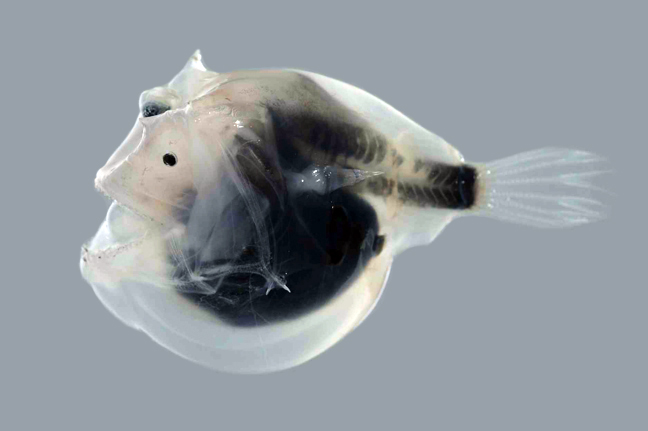Soft Leftvent Angler, Haplophryne mollis (Brauer 1902)

Soft Leftvent Angler, Haplophryne mollis, from SE of Norfolk Island, North Norfolk Ridge, Tasman Sea. Source: Mark McGrouther / NORFANZ Founding Parties. License: All rights reserved
A bizarre deep-sea anglerfish with totally transparent skin, a small bioluminescent lure, and dwarf males that become permanent sexual parasites on their adult female partners.
Adult females have a short, deep body, a large head with prominent spines on top and a large spine on the lower edge of the gill cover with 2-5 short radiating cusps. Unlike most species in the family Linophrynidae, the Soft Leftvent Angler lacks a chin barbel.
Males are obligatory sexual parasites on their larger female partners. Both males and females may only reach sexual maturity when they are in such an association.
Soft Leftvent Angler, Haplophryne mollis (Brauer 1902)
More Info
|
Distribution |
Widespread in deep oceanic tropical and warm temperate waters of all oceans. Known in Australian waters from off southern Queensland, and northeast of Lord Howe Island to off Cape Howe, Victoria, and eastern Tasmania, and off south-western Western Australia; also southwest of Norfolk Island in hte Tasman Sea, in depths of 200-2250 m. |
|
Features |
Dorsal fin rays 3; Anal fin rays 3; Caudal fin rays 9; Pectoral fin rays 15-16. Illicium very short, esca a simple bulb in small females, with 2-6 branches in larger individuals. Free-living males are relatively slender with a straight to slightly convex dorsal surface; upper denticular bone with 3-6 teeth fused at their bases; the paired lower denticular bone has 1-3 teeth on each side; jaw teeth present in free-living and recently attached males. Unlike all other deep-sea anglerfishes which are black upon capture (except Photocorynus), both male and female Soft Leftvent Anglers have totally transparent skin. |
|
Size |
Females to 15.9 cm, males to 1.6 cm |
|
Colour |
Freshly caught females have completely transparent skin, a black peritoneum and some pigmentation below the skin over the body musculature (Pietsch 2009). Free-living males are also transparent. |
|
Feeding |
Carnivore - feeds mostly on small meso- and bathypelagic fishes. |
|
Biology |
Like all deep-sea anglerfishes, females and males are markedly sexually dimorphic. Males are obligatory sexual parasites on their larger female partners. Sexual maturity of both males and females appears to be determined by the parasitic sexual association, rather than by size or age of the individuals (Pietsch 2009). Females with permanently attached males are relatively common, and the males are usually well-fused to the females. Males are known to attach to almost any position on their larger female partners - even onto the bioluminescent lure (esca). The lure contains symbiotic bacteria that produce the light. |
|
Remarks |
The relationships and biology of Haplophryne mollis has been studied by a number of authors, including Munk and Bertelsen, who determined that there is most likely a connection between the blood vessels of the females and their parasitic males. |
|
Similar Species |
H. mollis is the only species in the genus Haplophryne. Although almost all other ceratioid anglerfishes (160 + species) are black, adult Soft Leftvent Angler females are unique in completely lacking skin pigmentation. |
|
Etymology |
Haplophryne is from the Greek haplos meaning 'single' or 'simple', and phryne, meaning 'toad'. Regan (1912) based his description on a free-living male, which he presumably thought resembled a simple toad. |
|
Species Citation |
Aceratias mollis Brauer, 1902. Zoologischer Anzeiger 25(668): 297. Type locality: Indian Ocean. |
|
Author |
Bray, D.J & Thompson, V.J. 2017 |
|
Resources |
Soft Leftvent Angler, Haplophryne mollis (Brauer 1902)
References
Bertelsen, E. 1951. The ceratioid fishes. Ontogeny, taxonomy, distribution and biology. Dana Report 39: 276 pp.
Bertelsen, E. 1984. Ceratioidei: Development and relationships. pp. 325-334, In: Moser, H. G., W. J. Richards, D. M. Cohen, M. P. Fahay, A. W. Kendall, Jr., and S. L. Richardson (eds) Ontogeny and Systematics of Fishes, Spec. Publ. No. 1, Amer. Soc. Ichthy. Herpet., ix + 760 pp.
Bertelsen, E. & Pietsch, T.W. 1983. The ceratioid anglerfishes of Australia. Records of the Australian Museum 35(2): 77-99 figs 1-18
Brauer, A. 1902. Diagnosen von neuen Tiefseefischen, welche von der Valdivia-Expedition gesammelt sind. Zoologischer Anzeiger 25(668): 277-298.Knudsen, S. 2015. Haplophryne mollis. The IUCN Red List of Threatened Species 2015: e.T60470770A60791264. http://dx.doi.org/10.2305/IUCN.UK.2015-4.RLTS.T60470770A60791264.en. Downloaded on 02 February 2017.
Munk O, Bertelsen E (1983) Histology of the attachment between the parasitic male and the female in the deep-sea anglerfish Haplophryne mollis (Brauer, 1902) (Pisces, Ceratioidei). Vidensk Medd Dan Nathist Foren 144: 49–74.
Parr AE (1930) On the osteology and classification of the pediculate fishes of the genera Aceratias, Rhynchoceratias, Haplophryne, Laevoceratias, Allector, and Lipactis, with taxonomic and osteological description of Rhynchoceratias longipinna, new species, and a special discussion of the rostral structures of the Aceratiidae. Occas Pap Bingh Oceanogr Coll Yale Univ 3: 1–23
Parr AE (1930) On the probable identity, life-history and anatomy of the free-living and attached males of the ceratioid fishes. Copeia 1930: 129–135.
Pietsch, T.W. 1999. Families Caulophrynidae, Neoceratiidae, Melanocetidae, Himantolophidae, Diceratiidae, Oneirodidae, Thaumatichthyidae, Centrophrynidae, Ceratiidae, Gigantactinidae, Linophrynidae. pp. 2026-2037 in Carpenter, K.E. & Niem, V.H. (eds). The Living Marine Resources of the Western Central Pacific. FAO Species Identification Guide for Fisheries Purposes. Rome : FAO Vol. 3 1397-2068pp.
Pietsch, T. W. 2005. Dimorphism, parasitism, and sex revisited: modes of reproduction among deep-sea ceratioid anglerfishes (Teleostei: Lophiiformes). Ichthyol. Res. 52: 207–236.
Pietsch, T.W. 2009. Oceanic Anglerfishes. Extraordinary Diversity in the Deep Sea. Berkeley and Los Angeles : University of California Press pp. i-xii + 1-557.
Regan CT (1925) Dwarfed males parasitic on the females in oceanic angler-fishes (Pediculati, Ceratioidea). Proc R Soc Lond B 97: 386–400
Regan CT, Trewavas E (1932) Deep-sea anglerfish (Ceratioidea). Dana Rep 2: 1–113







